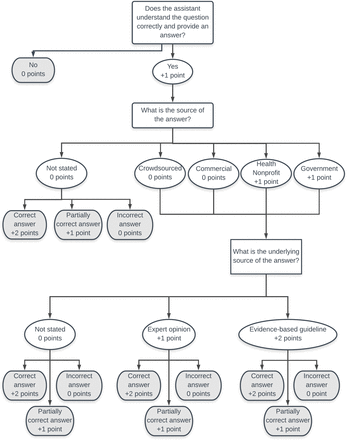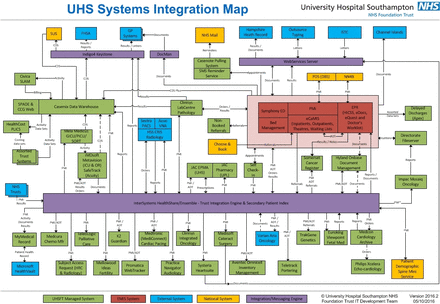Abstract
Objective To assess the quality and accuracy of the voice assistants (VAs), Amazon Alexa, Siri and Google Assistant, in answering consumer health questions about vaccine safety and use.
Methods Responses of each VA to 54 questions related to vaccination were scored using a rubric designed to assess the accuracy of each answer provided through audio output and the quality of the source supporting each answer.
Results Out of a total of 6 possible points, Siri averaged 5.16 points, Google Assistant averaged 5.10 points and Alexa averaged 0.98 points. Google Assistant and Siri understood voice queries accurately and provided users with links to authoritative sources about vaccination. Alexa understood fewer voice queries and did not draw answers from the same sources that were used by Google Assistant and Siri.
Conclusions Those involved in patient education should be aware of the high variability of results between VAs. Developers and health technology experts should also push for greater usability and transparency about information partnerships as the health information delivery capabilities of these devices expand in the future.
Introduction
Patients widely use the internet to find health information.1 A growing share of internet searches are conducted using voice search. In 2018, voice queries accounted for one-fifth of search queries, and industry leaders predict that figure will grow to 30%–50% by 2020.2–4 The growth in voice search is partially driven by the ubiquity of artificial intelligence-powered voice assistants (VAs) on mobile apps, such as Siri and Google Assistant, and on smart speakers, such as Google Home, Apple HomePod, Amazon Alexa and Amazon Echo.5 As VAs become available on more household devices, more people are turning to them for informational queries. In 2018, 72.9% of smart speaker owners reported using their devices to ask a question at least once a month.6 A number of health-related companion apps have been released for these VAs, suggesting developer confidence that VAs will be used in the health information context in the future.7 8
Many studies have evaluated the quality of health information websites and found varied results depending on the topic being researched.9–12 However, the literature evaluating how well VAs find and interpret online health information is limited. Miner et al found that VAs from Google, Apple and Samsung responded inconsistently when asked questions about mental health and interpersonal violence.13 Boyd and Wilson found that the quality of smoking cessation information provided by Siri and Google Assistant is poor.14 Similarly, Wilson et al found that Siri and Google Assistant answered sexual health questions with expert sources only 48% of the time.15
Recently, online misinformation about vaccines is of particular concern in light of outbreaks of vaccine-preventable diseases in the USA. Several studies have demonstrated that online networks are instrumental in spreading misinformation about vaccination safety.16–19 Because the internet hosts a large amount of inaccurate vaccination information, the topic of vaccines is ideal for testing how well VAs distinguish between evidence-based online information and non-evidence-based sites. At the time of writing, there are no studies evaluating how well VAs navigate the online vaccine information landscape. There are also no studies that have evaluated consumer health information provided by Amazon Alexa, which makes up a growing market share for voice search.
Study objective
This study aims to assess the quality and accuracy of Amazon Alexa, Siri and Google Assistant in answering consumer health questions about vaccine safety and use. For the purposes of this paper, ‘consumer health’ refers to health information aimed at patients and lay persons rather than healthcare practitioners and policymakers.
Limitations
The reviewers asked questions and gathered data on different dates, which may have led to variations in VA answers. However, the rubric was designed to evaluate answer quality and did not penalise answers from varying sources if the answer was correct and from an authoritative source. The scoring rubric was developed for this exploratory study. As such, it has not been assessed for reliability or validity and needs refinement in future studies to keep pace with new developments in VA technology. Additionally, because all accounts were set to default mode and cleared of search history, the VA answers may not reflect use cases where search results are tailored to the local use history of individual users. Finally, the authors chose to include the link provided via screen in the quality assessment. Some preliminary data show that users prefer audio output, so the overall scores for all assistants may have been lower if the rubric evaluated audio output only.33
Conclusions
This study assessed health information provided by three VAs. By incorporating user-generated health questions about vaccines into the set of test questions, the authors created realistic natural language use cases to test VA performance. After evaluating VA responses using a novel evaluation rubric, the authors found that Google Assistant and Siri understood voice queries accurately and provided users with links to authoritative sources about vaccination. Alexa performed poorly at understanding voice queries and did not draw answers from high-quality information sources. However, Alexa attempted to deliver audio-only answers more frequently than other VAs, illustrating a potential alternative approach to VA of health information delivery. Existing frameworks for information evaluation need to be adapted to better assess the quality of health information provided by these tools and the health and technological literacy levels required to use them.
Those involved in patient education should be aware of the increasing popularity of VAs and the high variability of results between users and devices. Consumers should also push for greater usability and transparency about information partnerships as the health information delivery capabilities of these devices expand in the future.






